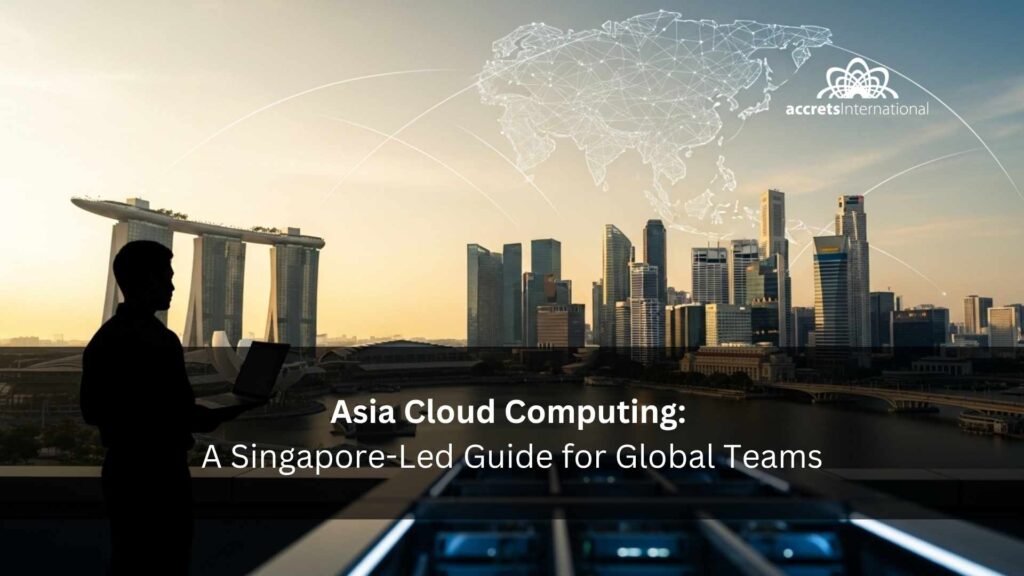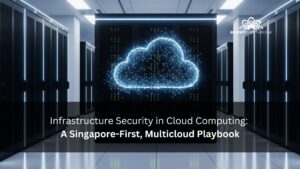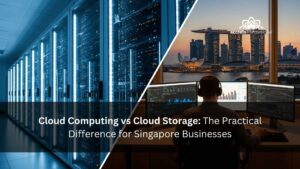Asia cloud computing in November 2025 is defined by fast growth, policy-shaped architectures, and Singapore as a reliable regional hub. This guide explains where to start, how regulations become design, and how to place workloads across APAC with confidence. We will read through this together until the end so you leave with a deployable plan and practical next steps.
Table of Contents
ToggleExecutive Snapshot: What’s really happening across APAC
- Growth remains broad-based. Adoption is accelerating across Southeast Asia, North Asia, and ANZ, driven by modernization, analytics and AI, and industry compliance programs.
- Policy is now architecture. Data residency, sectoral tech-risk rules, and cross-border transfer regimes directly shape region selection, encryption and HSM choices, and disaster recovery patterns.
- Singapore is the hub. With dense connectivity, strong rule of law, and mature cloud regions, many global teams establish Singapore as the control plane and extend to Jakarta, Bangkok, Kuala Lumpur, Taipei, Tokyo, Seoul, Sydney, and beyond.
- Capex proves momentum. Major providers have announced multi-year investments and additional Availability Zones across Singapore and ASEAN, lowering latency and bringing newer services closer to users.
What this means for you: Start where you can launch safely and operate economically, often Singapore, then expand with a repeatable playbook that reflects local rules, latency needs, and recovery targets.
Why Singapore is the natural landing zone for Asia
Singapore pairs policy clarity with world-class connectivity and predictable operations. Government programs have accelerated the public sector and enterprise appetite for cloud. For orientation, see how the city-state’s programs shaped readiness in this overview of Singapore’s Government Digital Transformation. For U.S. buyers comparing first deployments, this practical breakdown of speed, cost, and compliance explains why Singapore is often a top pick: Singapore Cloud VPS: A U.S. buyer’s field guide to speed, cost, and compliance in Southeast Asia.
When judging data-center options across the region, Singapore also shines as a risk-balanced anchor. This analysis of Tier-2 data centers in Southeast Asia and when U.S. companies should choose Singapore explains the operational logic behind common hub and spoke designs.
Country tiles: fast facts by market
How to use this section: For each market, we summarize regions and Availability Zones status, regulators, data-transfer stance, recent signals, and a two-line enterprise takeaway. This helps you shortlist locations quickly and dig deeper only where needed.
Singapore
- Regulators: Infocomm Media Development Authority for ICT and sector-specific rules such as the Monetary Authority of Singapore for financial institutions
- Transfer stance: Clear, well-documented requirements. Public sector workloads may route to dedicated environments where appropriate
- Signals: Mature ecosystem, strong interconnect density, and compliance tooling
- Enterprise takeaway: If you operate in finance, align early with MAS expectations. This explainer on cloud banking solutions in Singapore and South-East Asia shows how firms pair controls with delivery speed. For public workloads, evaluate GCC Government Cloud Singapore
Indonesia
- Regulators: Multiple sectoral bodies with explicit data residency expectations in key industries
- Signals: New regions and data centers broaden in-country options
- Enterprise takeaway: Plan for local-first data with cross-border analytics via governed gateways. Expect gradual service parity with Singapore
Thailand
- Regulators: Sector rules maturing with ongoing data center investments
- Enterprise takeaway: Attractive for edge latency to Thai users. Keep core systems in Singapore for the control plane and consider DR in Australia or Japan based on targets
Vietnam
- Regulators: Data localization themes and evolving guidance
- Enterprise takeaway: Expect policy-led architecture. Emphasize strong encryption, auditable transfers, and documented data flows
Malaysia
- Regulators: Sector guidance advancing with new regions expanding options
- Enterprise takeaway: Useful as a secondary ASEAN node for DR or low-latency workloads serving the Klang Valley and nearby markets
Philippines
- Regulators: Sector-specific oversight with maturing infrastructure
- Enterprise takeaway: Consider edge services and CDN first. Pin sensitive data in Singapore or a designated in-country repository
India
- Regulators: Strong residency and sector mandates from multiple regulators
- Enterprise takeaway: Treat as an independent domain with in-country primary and a clear cross-region DR plan. Be explicit about key management
Japan
- Regulators: Mature compliance landscape
- Enterprise takeaway: High availability and service breadth. Pair with Korea or Singapore for cross-border analytics with strict key management and privacy commitments
South Korea
- Regulators: Clear and strict expectations for reliability and data protection
- Enterprise takeaway: Valuable for consumer-scale, low-latency apps. Use Singapore or Japan for analytics consolidation where lawful and appropriate
Australia and Taiwan
- Regulators: Mature in Australia with tightening in Taiwan. Strong data center growth in both
- Enterprise takeaway: Australia is excellent for DR from Singapore. Taiwan adds North Asia proximity with improving peering
From regulation to architecture: how policy translates into design
Compliance requirements drive the blueprint. Use the following mapping to avoid surprises and speed approval.
- Data residency
Region pinning and data-classification gates. Encrypt at rest with customer-managed keys. Document lawful cross-border transfers with clear patterns and audit trails - Sectoral tech risk, including financial services
HSM-backed key hierarchies, network micro-segmentation, privileged-access workflows, and immutable logging with strong monitoring - Retention and audit
WORM or immutability for backups, lifecycle policies, and drill-based recovery evidence - Third-party risk
Shared responsibility matrices and vendor exit plans that are tested end to end, including images, infrastructure as code, and data export
For a Singapore-anchored security approach, this Singapore-first multicloud security playbook shows how to implement guardrails without blocking delivery. Where specialist skills are scarce or timelines are tight, targeted support through cloud security consulting services in Southeast Asia can shorten time to control and audit readiness.
Investment watch: 2024 to 2025 cloud and data center moves
Across 2024 and 2025, hyperscalers announced additional capital expenditure, new Availability Zones, and new country entries throughout Singapore and ASEAN. The implications for operators include:
- Lower latency and fresher services that reduce the need for back hauling
- New interconnect options that change cost models for cross-region replication and analytics
- Improved talent availability as ecosystems scale around new regions
Maintain a lightweight internal timeline that tracks month, provider, market, and impact. This single page guides backlog prioritization, disaster recovery choices, and hiring plans.
Workload placement: practical patterns for Asia
1) Hub and spoke with Singapore as the control plane
Keep shared services, keys, and observability in Singapore. Deploy latency-sensitive components in local spokes. For many teams, a measured hybrid approach is the safest on-ramp. This primer on hybrid cloud providers in Singapore for U.S. teams outlines the staged model that avoids risky big-bang cutovers.
2) Modernize before you move everything
If you are heavy on virtualization, evaluate platform choices early. This guide to VMware alternatives helps prevent lock-in and licensing shocks during migration.
3) Align service models with automation
Revisit the advantages of IaaS for control. Understand the difference between platform and infrastructure as a service. Decide how far to push automation by comparing infrastructure as code vs infrastructure as a service. When vendor selection time comes, shortlist with this overview of infrastructure as a service vendors.
4) Design for portability
If multi cloud is in scope, build for inter-cloud interoperability from day one. This explainer on inter-cloud services across platforms shows how to reduce switching costs without sacrificing performance.
Sector mini caselets with Singapore examples and Asia deployment
Finance in Singapore and South-East Asia
Teams map MAS aligned controls onto reference architectures that combine customer managed encryption keys, strong identity, and immutable logs. Disaster recovery drills provide evidence for auditors. For a starting point, see cloud banking solutions in Singapore and South-East Asia.
Healthcare
Sensitive PHI stays in-country or pinned to Singapore with auditable transfers. Analytics run in controlled zones with privacy features and data minimization. Resilience depends on tested backup and disaster recovery. For a pragmatic checklist, see the U.S. buyer’s guide to backup and disaster recovery with Singapore cloud providers.
Retail and eCommerce
Peak seasons require edge latency planning, CDN strategy, and cost control at scale. Day-2 operations improve when incident and change flows are anchored by local expertise. For an operating model, read the field guide to business IT support in Singapore.
Light pathways to solutions
- Enterprise connectivity and cross-border routing
If you need stable, high performance routing, including routes to and from China, evaluate enterprise connectivity, consider the Teridion connectivity solution, and review Teridion cross-border connection for China for predictable performance - Resilient infrastructure and disaster recovery
Rapid recovery depends on repeatable runbooks and tooling. Many teams combine IT-DR-as-a-Service with managed backup services on a hardened cloud infrastructure-as-a-service foundation, operated by experienced managed IT services - Enterprise applications
Standardize collaboration and core apps with enterprise applications, including enterprise email and Microsoft 365, online collaboration tools, or SAP Business One - Private and brokered cloud
Some regulated or latency critical workloads still fit best on an on-premise private cloud or through a cloud service broker, while strategic platforms can consolidate on enterprise cloud computing. If you prefer a single partner to orchestrate the journey, review the managed cloud service provider overview and why organizations choose Accrets in Why Accrets. Solution one-pagers are under solution brochures
Data center tiers in practice
Balance risk and cost by matching facilities to workload criticality. Not every workload needs Tier-4 or Tier-5. These primers on the Tier-1, Tier-3, and Tier-4 models and what Tier-2 means in the regional context are useful decision aids. For future ready discussions, see the emerging Tier-5 concept.
Regional execution improves with the right operating partners. When skills are tight, IT infrastructure management and IT outsourcing keep day-2 steady. Learn the basics of what is IT infrastructure management services and what is IT outsourcing services, and consider an infrastructure IT outsource service in Singapore for scale.
Talk to an Accrets cloud expert
Have a tricky Asia deployment or governance question
If you want a seasoned team to pressure test your plan or co-design controls that pass audit without slowing delivery, fill this short form for a free consultation on asia cloud computing
Fill the form for a free consultation with an Accrets Cloud Expert
Methodology, sources, and last updated
This guide synthesizes current analyst outlooks, public regulatory documentation, and market announcements, alongside hands-on experience designing and operating Singapore anchored multi-region architectures for global teams. We prioritize primary sources for policy interpretations and maintain a lightweight internal capex and region timeline to track market shifts.
Last updated: November 2025
Dandy Pradana is an Digital Marketer and tech enthusiast focused on driving digital growth through smart infrastructure and automation. Aligned with Accrets’ mission, he bridges marketing strategy and cloud technology to help businesses scale securely and efficiently.




